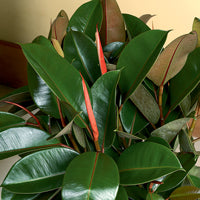
Take the Ficus family for example. Two of my favorite plants, fiddle leaf fig and rubber plant are members of this group, yet you’d never know they are cousins just by looking at them.
Fiddle leaf fig, (Ficus lyrata, left) for example, develops huge, leathery, paddle-shaped foliage that adds beauty and interest to any room of your house. (That's why it’s the darling of the interior design industry.)
Native to the jungles of West Africa, fiddle leaf fig requires bright indirect light (a tiny bit of direct sun is ok) and consistently moist, but not wet soil. Indoors, fiddle leaf fig has a tall, narrow habit and can grow 6 to 8 feet tall. There’s also a dwarf form called 'Little Fiddle' fiddle leaf that remains more compact than the standard variety. These big beauties hate cold drafts so keep your fiddle leaf fig away from leaky windows and doors during the winter.
 Rubber plant (Ficus elastica, left), develops thick, oval, green, burgundy, or variegated leaves and thrives in bright light and slightly moist soil. It’s native to parts of Asia including east India, China, Indonesia, and Malaysia. Like its Fiddleleaf cousin, Rubber plant prefers slightly moist soil, but if you forget to water now and then, the plant won’t mind at all.
Rubber plant (Ficus elastica, left), develops thick, oval, green, burgundy, or variegated leaves and thrives in bright light and slightly moist soil. It’s native to parts of Asia including east India, China, Indonesia, and Malaysia. Like its Fiddleleaf cousin, Rubber plant prefers slightly moist soil, but if you forget to water now and then, the plant won’t mind at all.
I once found two very sad looking 18-inch-tall burgundy rubber plants on sale at my local garden center. I don’t think they’d been watered for a long time. But, once I brought them home, repotted them together in a larger pot with fresh soil, and gave them a drink they sprang back to life. Today, my two sad adoptees have formed one large, thick, 5-foot-tall bush that looks amazing on my summer patio. They spend the winter indoors because they are frost sensitive.
Other members of the Ficus family also make outstanding houseplants. They include: Ficus 'Alii', weeping fig, dwarf weeping fig, climbing fig, and creeping fig. They all look very different and come from different parts of the globe, but they’re all relatives with similar cultural needs.
Written by Doug Jimerson

















